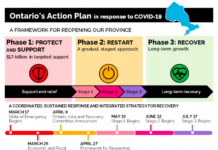GoosEx is LoopX AI’s all-weather autonomous last-mile delivery robot that carries food to customers on the University of Waterloo campus.
Founded in Jan 2022 by Chao Yu, Lucas Cui, Bruce Huang, and James Zhang, a group of roboticists from UW, LoopX is a Waterloo-based startup providing AI-powered vehicle-agnostic autonomy solutions. Having had their autonomy solution deployed and verified on a variety of vehicles, they are on a mission to better the world through autonomy.
Vehicle-agnostic autonomy solutions refer to the use of artificial intelligence (AI) algorithms to enable the unmanned operation of vehicles without the need for specific hardware or software modifications to the vehicles themselves. This is noteworthy because it promotes the accessibility of their product to a wider range of organizations and industries since integrating their technology into existing fleets is more cost-effective and flexible. Cui mentioned, ‘it’s like adding a brain to an existing machine.”
The pilot operation of GoosEx was launched in the fall of 2022. Over the course of the term, from September to December, this robot has successfully delivered over 500 food orders to its customers in a timely and efficient manner. More recently, LoopX was sponsored by the Ontario Vehicle Innovation Network, Ontario’s flagship initiative for the automotive and mobility sector. Along with the opportunity for sponsorship, they were also invited to exhibit their autonomous driving technology in the 2023 Canadian International AutoShow held at Metro Toronto Convention Centre in late February.
So, what’s next for LoopX?
Evidently, the team at LoopX puts an emphasis on using automation for the betterment of society. The motivation behind GoosEx was not only to find a way to eliminate the need for customers to be exposed to COVID-19 but also the delivery drivers.
Scalability is a huge concern for all startups and LoopX is no exception. The team delivered a very successful demo to the City Council of Toronto, but in the end, found that their product couldn’t be deployed onto the public streets due to vehicle regulations anytime soon. Cui reported, “in terms of technology and safety, we have multiple safety layer designs, but we just have no control over the legislative process and so we decide to pivot from that.”
They have now determined another sector that would benefit from their technology as they pivot their business from autonomous delivery towards autonomous mining, which they believe is “more doable, more scalable, and more profitable”. Their proprietary AI-powered solution dramatically improves both the safety and the productivity of underground mining. They aim to lead the autonomous underground mining industry worldwide.
A huge problem with the mining industry is the fact that they bear difficulty in maintaining their workforce. There are high turnover rates because of how hazardous the environment is. Due to the nature of the availability of resources, or rather, the lack of them, miners are having to dig deeper and deeper to get in contact with the minerals they are looking for. Proportionally, the work environment starts to get worse as well. Miners endure the risk of hearing damage, lifting injuries, and most of all, lung damage due to regular exposure to harmful contaminants in the air they breathe.
Their solutions for underground mining vehicles include the Advanced Driver Assistant System and Autonomous Driving System. These systems include lidar, radar, cameras, and infrared sensors, as well as a controller equipped with their AI-powered autonomous software that can be deployed on any type of existing mining vehicle, eliminating waste. Their proprietary multi-modal localization method enables these vehicles to navigate seamlessly both over and underground. Their technology requires testing by an on-site technician to check if it meets the required radio frequency requirements. They are working with KPI Industrial Controls from Val Caron, Ontario for their certification. However, it is an exciting time for LoopX as they are nearing the testing stage of their implementation with their demonstration period to be scheduled at the NORCAT underground mine in Sudbury, Ontario in April 2023 and onwards.
Possible challenges that they already have identified are the potential for dust to interfere with the sensors’ perception, the increased difficulty of underground driving compared to driving on pavement, and the absence of a GPS system to guide the vehicle. The LoopX team has promised to persevere and come up with resolutions for these obstacles to ensure that their vehicles can safely and effectively navigate various driving conditions.
LoopX has had several partnerships in order to bring their vision into a reality, including Rogers, Amazon Web Service, Hexagon, and Ericsson. LoopX led the joint group and successfully fulfilled the proof of concept of 5G application for autonomous driving. For their mining project, they are working with NORCAT – a company that works with community partners to help start and accelerate the growth of innovative companies that show promise to drive future economic and social prosperity for Canada.





























